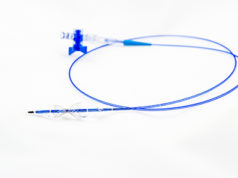
A new study indicates that transcatheter mitral valve implantation (TMVI) with the Tiara valve (Neovasc) can be safely and successfully implanted in patients with pre-existing aortic valve replacement. It also shows that the procedure can be performed without causing left ventricular outflow tract (LVOT) obstruction or any other mechanical or haemodynamic interference.
Anson Cheung (St Paul’s Hospital, University of British Columbia, Vancouver, Canada) and others write in Circulation: Cardiovascular Interventions that compared with transcatheter aortic valve implantation (TAVI), TMVI “seems to be more complex and more challenging”. They add that one of the challenges is the risk of LVOT obstruction and this risk may be higher in patients who have previously undergone some form of aortic valve replacement (whether via surgery or via TAVI) “because patients with prior aortic stenosis often have left ventricular hypertrophy and small left ventricular cavity, and the frame of the prosthesis can extend into the LVOT”. Furthermore, Cheung et al observe that the anchoring mechanism of a TMVI device “may interfere with the proper functioning of an aortic prosthesis”, meaning that “aortic prostheses have been considered a relative contraindication to TMVI”.
However, the authors state that the Tiara valve has been designed to “match the natural orifice of the mitral valve, avoiding impingement of the LVOT and to prevent any interference with the aortic valve or prosthesis”. Therefore, in this present study, they assessed the periprocedural and short-term outcomes of 12 patients with prior aortic valve replacement and with mitral regurgitation who underwent TMVI with the Tiara device. All patients in the study were at high surgical risk and unsuitable for alternative mitral valve repair or replacement therapies.
Cheung et al report that all 12 Tiara procedures were completely successfully and uneventfully, with no conversion to open heart surgery or need for mechanical haemodynamic support. They add that mitral regurgitation was eliminated immediately after implantation and “the degree of mitral regurgitation at predischarge and at 30-day follow-up echo was none or trace”. There were no deaths, myocardial infarctions, strokes, bleeding or need for pacemaker implantation at either the periprocedural stage or at the 30-day follow-up stage. According to the authors, no LVOT obstruction was observed in any of the patients.
They conclude: “TMVI with the Tiara valve in patients with pre-existing aortic valve prosthesis was safely and successfully implanted and was not associated with LVOT obstruction or with any mechanical or haemodynamic interference. The design of this device affords a stable and predictable implantation, representing a reasonable alternative to treat this particular subset of patients.”
Cheung told Cardiovascular News: ““The Neovasc Tiara TMVIdevice has unique valve design—the D-shaped valve is less protrusive into the LVOT and the anchoring tabs capture the anterior leaflet, eliminating the risk systolic anterior motion, causing LVOT obstruction. Additionally, the two anterior tabs bisect the LVOT and do not interfere with the pre-existing surgical aortic valve prosthesis.”









